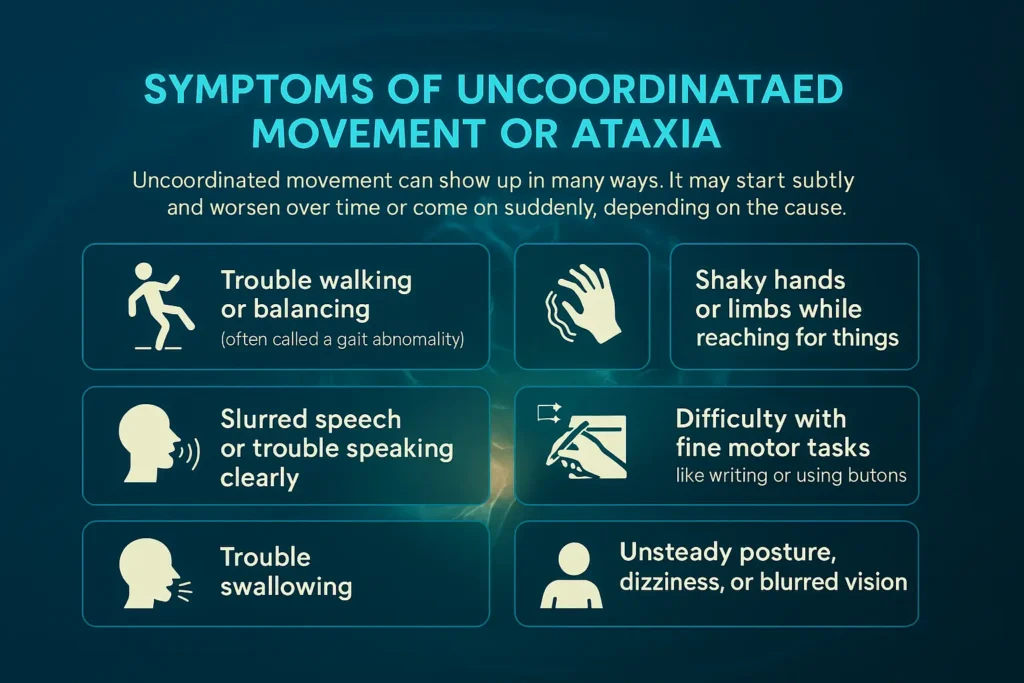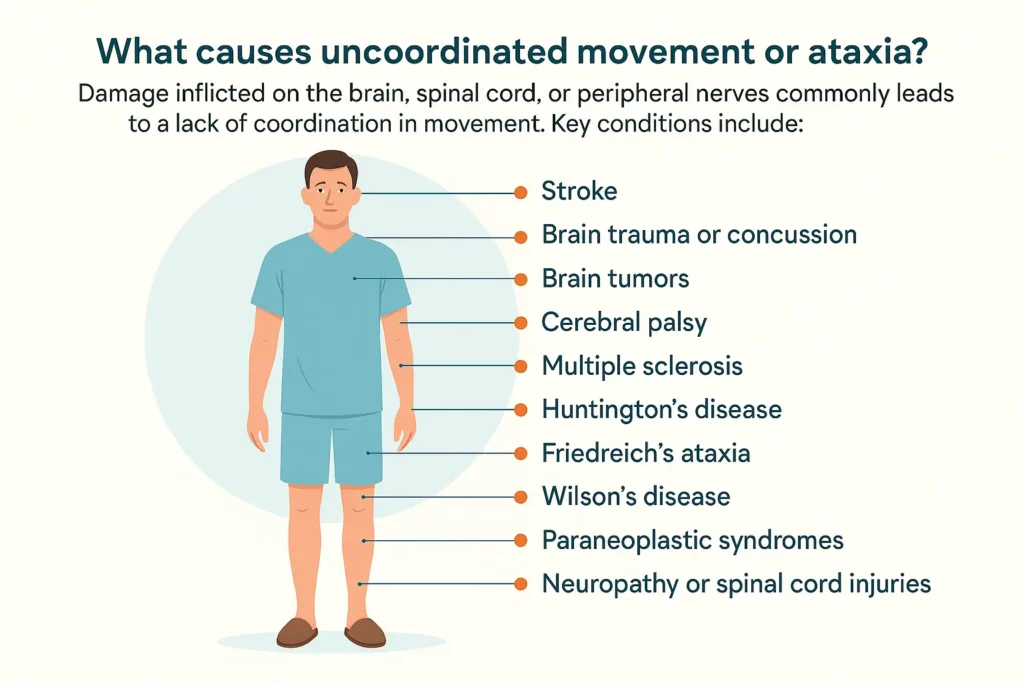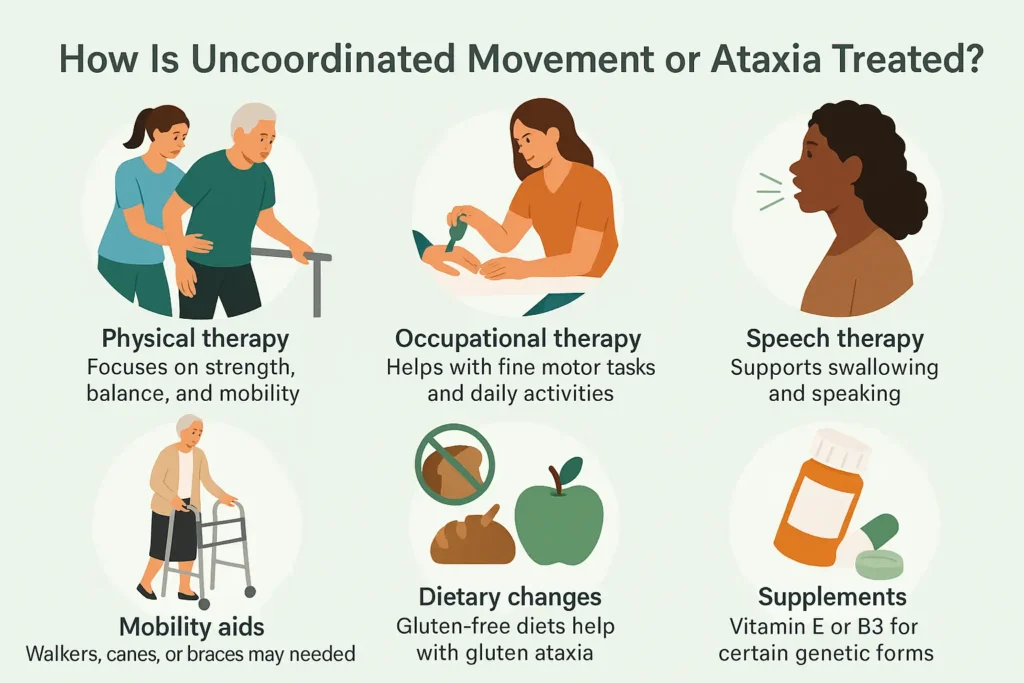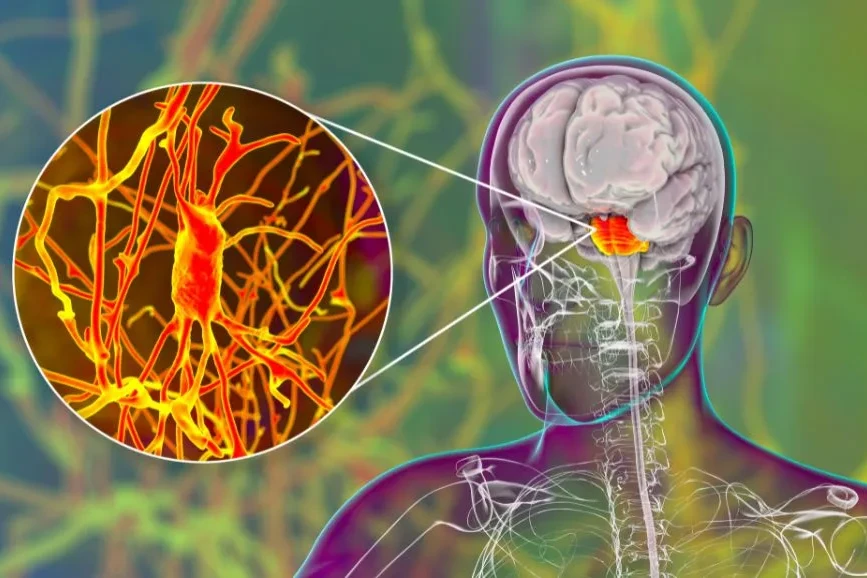Uncoordinated movement is when the body struggles to control motion properly. It can affect walking, speaking, writing, or even holding a spoon. These movements may appear jerky, shaky, or simply off-balance.
The medical term often used for uncoordinated movement is “ataxia.” This condition happens when the brain, especially the part called the cerebellum, is injured.
The brain, muscles, and nerves must work together smoothly for the body to move in a coordinated way. When something interrupts this system, movement becomes difficult.
In this blog, we’ll cover the symptoms, causes, diagnosis, and treatment options for uncoordinated movement. We’ll also answer common questions to help you understand this condition better.
Table of Contents
ToggleSymptoms of uncoordinated movement or ataxia
Uncoordinated movement can show up in many ways. It may start subtly and worsen over time or come on suddenly, depending on the cause.
 Some of the most common signs include:
Some of the most common signs include:
- Trouble walking or balancing (often called a gait abnormality)
- Shaky hands or limbs while reaching for things
- Slurred speech or trouble speaking clearly
- Difficulty with fine motor tasks like writing or using buttons
- Trouble swallowing
- Unsteady posture, dizziness, or blurred vision
These signs may vary from mild to severe. Often, people mistake these symptoms for a stroke or neurological issue. It’s important to seek medical help, especially if the symptoms appear suddenly.
Loss of coordination, tremors, and shaky hand movements are early signs. As it worsens, people may struggle with everyday tasks, like eating or walking.
What causes uncoordinated movement or ataxia?
The causes of uncoordinated movement are wide-ranging. It can be triggered by injury, illness, toxins, or genetic disorders. Some causes are short-term, while others are long-term or even permanent.
 Let’s break down the most common causes:
Let’s break down the most common causes:
Disease and injury-related causes
Damage inflicted on the brain, spinal cord, or peripheral nerves commonly leads to a lack of coordination in movement. Key conditions include:
- Stroke
- Brain trauma or concussion
- Brain tumors
- Cerebral palsy
- Multiple sclerosis
- Huntington’s disease
- Friedreich’s ataxia
- Wilson’s disease
- Paraneoplastic syndromes
- Neuropathy or spinal cord injuries
These conditions interrupt the pathways responsible for movement, leading to impaired coordination, shaky limbs, or slow responses.
Inherited disorders like Friedreich’s ataxia affect energy supply in the nervous system. Wilson’s disease leads to the accumulation of copper, which negatively impacts both brain and liver functions.
Toxins
Exposure to certain harmful substances can also cause uncoordinated movement. This includes:
- Alcohol (long-term use damages the cerebellum)
- Anti-seizure or psychiatric medications
- Chemotherapy drugs
- Lithium
- Cocaine or heroin
- Heavy metals like mercury or lead
- Solvents like toluene
Toxins interfere with nerve signals and lead to poor motor control or full coordination impairment.
Even some prescription medications can lead to coordination impairment when taken for a long time.
How is uncoordinated movement or ataxia diagnosed?
Although uncoordinated movement cannot be cured, the treatment varies based on its cause.
If it’s due to an infection, stroke, or vitamin deficiency, addressing the root problem can improve symptoms. Chronic cases need long-term care.
 Here are the most common treatments:
Here are the most common treatments:
- Physical therapy: Focuses on strength, balance, and mobility
- Occupational therapy: Helps with fine motor tasks and daily activities
- Speech therapy: Supports swallowing and speaking
- Mobility aids: Walkers, canes, or braces may be needed
- Dietary changes: Gluten-free diets help with gluten ataxia
- Supplements: Vitamin E or B3 for certain genetic forms
For motor dysfunction caused by medication or toxins, changing the drug or detoxing from exposure may help. In genetic cases, the focus is on managing symptoms and improving daily function.
Living with Uncoordinated Movement
It can be tough dealing with daily challenges. You might feel frustrated or even embarrassed. That’s normal.
Tips to manage daily life:
- Declutter walkways and avoid loose rugs
- Use shower chairs or handrails
- Choose clothes with Velcro or magnetic fasteners
- Practice movement exercises regularly
- Use tools like adaptive utensils and large-handle cups
Also, don’t ignore your mental health. Support groups and therapists can help you manage the emotional side of clumsiness and reduced independence.
Prevention and Risk Management
You can’t always prevent uncoordinated movement, especially if it’s inherited. But here are steps that help:
- Avoid alcohol and recreational drugs
- Wear helmets and seatbelts to prevent brain injuries
- Manage chronic diseases like diabetes
- If you have a family history of ataxia, it is important to have regular medical checkups.
- Be cautious with medications that affect the brain
Making your home safe and staying alert to new symptoms also reduce risks of injury.
When to See a Doctor?
Not all coordination issues are serious. But if uncoordinated movement becomes frequent or worsens, get help.
You should see a doctor if:
- You notice trouble walking, speaking, or balancing
- Symptoms come on suddenly
- You’re at risk for stroke or neurological illness
- You’re on long-term medication known to affect the brain
Never ignore sudden or fast-changing symptoms. It may signal a serious problem needing urgent care.
Conclusion
Uncoordinated movement isn’t always a harmless issue. It could be a symptom of a bigger health problem like a neuromuscular disorder, stroke, or brain injury. Early attention and care can make a huge difference.
If you notice ongoing changes in how you move or balance, don’t ignore it. Your body’s telling you something. Listen early to live better.
FAQs About Uncoordinated Movement
What does it mean if someone is uncoordinated?
It means the brain and body aren’t working in sync, causing movement issues like shaking, tripping, or awkward gestures that affect walking, speaking, or daily tasks.
What is a synonym for uncoordinated movement?
The medical synonym is ataxia. Other terms include clumsiness, impaired coordination, or coordination impairment, all describing trouble with smooth, controlled motion.
What are uncoordinated movements called?
They’re known as ataxic movements, which describe jerky, uneven, or unstable actions caused by damage to the nervous system or cerebellum.
What is uncoordinated movement a symptom of?
It can be a symptom of a stroke, brain injury, neuromuscular disorder, vitamin deficiency, or a reaction to toxins or medication.
Is uncoordinated movement the same as ataxia?
Yes, ataxia is the uncoordinated movement medical term, often used by doctors to describe poor balance and control caused by nerve or brain damage.
Can stress or anxiety cause uncoordinated movement?
Yes, extreme stress can lead to temporary uncoordinated movement, but it usually improves when the stress is managed or the anxiety is treated
Is uncoordinated movement permanent?
It depends on the cause. If it’s due to injury or toxins, it may go away. Genetic or chronic diseases may cause long-term or worsening symptoms.
Can children have uncoordinated movement?
Yes. Children may develop uncoordinated movement due to cerebral palsy, genetic disorders, or delayed motor development. Early intervention often improves their function.
About The Author

This article is medically reviewed by Dr. Chandril Chugh, Board-Certified Neurologist, providing expert insights and reliable health information.
Dr. Chandril Chugh is a U.S.-trained neurologist with over a decade of experience. Known for his compassionate care, he specializes in treating neurological conditions such as migraines, epilepsy, and Parkinson’s disease. Dr. Chugh is highly regarded for his patient-centered approach and dedication to providing personalized care.
→ Book a consultation to discover which remedies suit your needs best.




